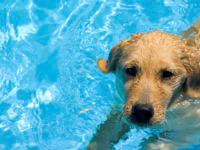If you google “how to introduce children to dogs,” the main articles that pop up are mostly titled “how to introduce dogs to children.” Often, people assume dogs should conform to children no matter how the child behaves, but that isn’t necessarily fair.
Dogs should absolutely learn how to behave around kids, but kids should also learn the right way to behave around dogs.
Most of all, when dogs and kids meet, it’s the adults’ responsibility to make sure the child is educated, the dog is supervised and not violated, and everyone is comfortable.
Consider the age of the child.
If the child is very young, they may not be able to understand the ground rules of how to treat a pet. Toddlers don’t have great motor control and often grab, slap, or shriek, which will startle or frighten most dogs and could lead to growling or bites. The dog’s instinct is to run or defend itself when hurt or scared, so when teaching a small child to interact with your pet, keep a close eye on both the child and animal. If the animal shows any signs of discomfort or irritation, discontinue the meeting.
Teach the child about boundaries.
Children often don’t know when to slow down, what might hurt, or what noises might startle an animal. That’s part of being a child, and being the supervising adult means it’s your job to teach them how to behave respectfully to the dog. Children should avoid screaming, poking, hitting, and fast movements until they know the dog well. They should always be supervised around your dog.
Dogs shouldn’t have to tolerate abuse, even from kids.
Some people think children can do no wrong and dogs should tolerate anything the child does, but this isn’t fair to the animal. The sooner children learn about how to respect other living beings, the better off they will be. Learning polite behavior around pets will put them at lower risk for being attacked by a less obliging animal later on.
Dogs need to learn manners, too.
Some dogs can’t get enough of kids, and when they get too excited, it’s your job to call a “time out.” If your dog jumps on the child, puts a paw on their shoulder, or mouths the child, use a consistent phrase to signal a pause in play time. Immediately separate the two and don’t let your dog play again for a minute. Do this consistently until Fido gets the message.
If you have more specific questions about introducing a child to your dog, call us at LazyPaw Animal Hospitals. We are a Frisco vet that provides comprehensive veterinary services including dental care for pets, pet vaccinations, and spaying and neutering done by our trained animal surgeons. We are behavioral experts, and we’re happy to talk about your situation one on one!


